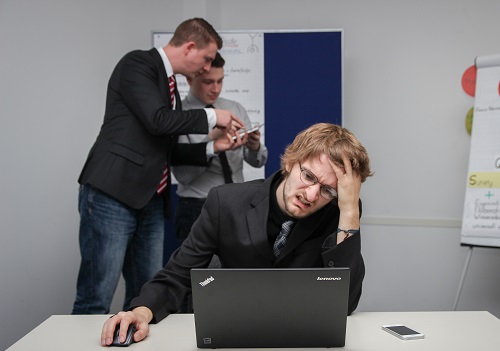There are generally two kinds of changemakers – the visionaries and executors. The visionaries are great at thinking big. They love to create ideas for changing the world. However, visionaries tend to have difficulty putting their ideas into action because they don’t enjoy doing the tasks that go along with it. Then there are the executors who are great at making things happen. However, executors can get so bogged down in the details that they lose sight of the bigger picture. When this happens, the day-to-day work can become disconnected from the larger goal they are working towards.
To achieve positive change on a larger-scale we need both visionaries and executors who can pull together in the same direction. This happens when visionaries and executors not only recognize and appreciate the positive aspects they each bring to their work, but they are also able to manage the creative tension that exists between them.
Tension is a natural part of collaboration
Maximizing the upsides of seemingly opposing positions involves navigating tension. While we may think of tension as something we would prefer to avoid, it’s a natural part of collaboration. When we bring together people with different perspectives, ideas, and ways of working there is bound to be disagreement. Tension in collaboration occurs when people’s positions come across as being mutually exclusive, like being task- or relationship-oriented. If tension isn’t addressed this can lead to feeling stuck about how best to move forward.
Through practice we can identify seemingly mutually exclusive positions early on and come up with solutions that maximize the benefits of both. The following examples illustrate tensions commonly experienced in multi-sector, multi-organizational networks along with ideas for overcoming polarization when the group appears to be stuck.
Transform tension into a source of innovation and creativity
When there are seemingly opposing views there is a tendency to try to “win others over to your side” by convincing them of their merits of your position, which has the potential to devolve into unhealthy conflict. Lack of agreement can be useful for seeing a situation from multiple sides, which is part of developing a comprehensive understanding of the system the group is working together to change.
Sourcing different perspectives can also help groups make better decisions. Additionally, breakthroughs can emerge when we’re open to ideas we hadn’t previously considered. In one instance, a business leader recognized that activists who were calling for the company to adopt environmentally sustainable practices could, instead of being resisted, be viewed as unlikely allies for supporting efforts inside the company to bring about change.
In my work with a network there is a divergence of opinion among participants about how meaningful change is defined and what needs to happen to accelerate progress towards an ambitious collective goal. My colleagues and I are preparing participants to engage in a dialogue that aims to leverage tension within the larger context of the group’s work as a catalyst for transformational change. This involves recognizing that the group has reached a pivotal moment in which individual efforts are coalescing towards a tipping point for sector-wide change.
Taking advantage of this opportunity to work together towards reaching this tipping point involves focusing on shared interests and using collaborative leadership skills to create a shared understanding of the problem to be addressed, align participants around a common powerful goal, and understand each other’s lived experience of the problem using games and facilitation methods, like Heard, Seen, Respected. A successful outcome will hinge on coming up with ideas to build on and scale up what is already working and generating commitment to pull together in the same direction.
Turn downsides into upsides by generating win-wins
Fundraising can also be a source of tension in collaboration when securing funding is contingent upon demonstrating results, and producing results is contingent upon having funding. This can be particularly challenging for networks since systems change doesn’t align with short-term grant cycles. In addition to seeking out funders that are knowledgeable about systems change and are experienced in providing philanthropic support to networks, this tension can be productively managed by seeking out win-wins.
For example, agreeing with funders to measure and demonstrate progress by using benchmarks as stepping-stones to achieving longer-term results. This also has the benefit of enabling the network to stay on track towards achieving its goal. A network I’ve been involved in keeps funders in the loop about what is happening in between reporting cycles through newsletters, invitations to events, brief update emails, and periodic calls.
Productively managing tension in collaboration takes awareness, healthy relationships, and practice. In both of these examples, the starting point for maximizing the benefits of seemingly opposing positions is being aware that a polarity exists. It takes effort to avoid being caught up in an unhealthy pattern. One way to do so is to notice when the group appears to be stuck and examine whether this situation is characterized by opposite or contradictory positions.
It’s easier to understand where someone else is coming from if you’re willing to genuinely hear a different point of view and learn from other people’s experiences. For this to happen we need to take the time to build relationships grounded in trust and open communication. Lastly, engaging with tension in collaboration comes with practice. This begins with acknowledging that tension is a natural part of collaboration and the upsides of managing it productively. Consider sharing responsibility for surfacing and addressing tension with your colleagues or other members of your network.
An irony of changemaking is that in our pursuit of changing social systems, we often need to begin with changing ourselves and how we relate to the people we work with. We can make a conscious choice to reframe what on the surface appears to be a negative situation as a positive outcome that leads to both better results and healthier relationships.
Kimberley Jutze is a social activist and founder of Shifting Patterns Consulting, a Certified B Corporation that helps changemaker leaders work better together to achieve greater impact. She specializes in helping networks and other collaborative groups increase their productivity and engagement. You can follow her on Twitter at @ShiftPatConsult and LinkedIn


